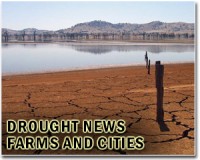 |
Los Alamos NM (SPX) Mar 03, 2011 There's an old saying that if you don't like the weather in New Mexico, wait five minutes. Maybe it should be amended to 10,000 years, according to new research. In a letter published recently in the journal Nature, Los Alamos National Laboratory researchers and an international team of scientists report that the Southwest region of the United States undergoes "megadroughts"-warmer, more arid periods lasting hundreds of years or longer. More significantly, a portion of the research indicates that an ancient period of warming may be analogous to natural present-day climate conditions. If so, a cooler, wetter period may be in store for the region, unless it is thwarted by increased concentrations of greenhouse gasses in the atmosphere that could warm the planet. Using a long core of sediments obtained in 2004 from beneath a dry lakebed located on the Valles Caldera National Preserve-an 86,000-acre grassland located on the site of a dormant prehistoric volcano about 20 miles west of Los Alamos-the researchers were able to peer back in time into the climate as it existed between 360,000 and 550,000 years ago. Layers in the 260-foot-long sediment core were easily distinguishable, and were bounded by distinct layers of volcanic ash that allowed for very accurate dating. Researchers looked at chemical constituents trapped within the layers as well as plant and pollen debris to characterize the climate conditions of the time. The sediment layers from beneath the South Mountain Lake covered two "interglacial" periods. Such periods are significant because they represent a time between ice ages when warmer temperatures mimicked present-day temperatures. The ancient interglacial period, known as Marine Isotope Stage 11-MIS 11 for short-lasted about 50,000 years and included, among several periods of climatic variation, one definitive megadrought period followed by a cooler period. Prior to the study, detailed data about MIS 11 had been scarce because most of the information was gathered from Antarctic ice cores or marine sediments. The terrestrial record obtained beneath South Mountain Lake revealed a bounty of information that nicely details the ancient climate. The oldest warm period in MIS 11 appears somewhat analogous to the present-day Holocene interglacial period, which has been ongoing for about the past 10,000 years. During MIS 11, the ancient climate warmed dramatically by about 14 degrees Fahrenheit. This warming in the wake of a preceding period of cold gave rise to an abundance of plant life and seasonally wet conditions. As warming continued, grasses and shrubs died off and lakes dried up. The ensuing drought lasted thousands of years before ending abruptly with a cooler, wetter period. The research could indicate that the Southwest, having been through a present-day drought period that included the historic Dust Bowl, might be due for a change unless increased concentrations of greenhouse gasses interfere. "Results from this study have implications for the development of models that could predict future megadroughts and other climate conditions in the Southwestern United States," said Jeffrey Heikoop, leader of the Los Alamos study team. Peter Fawcett of the University of New Mexico was principal researcher for the study. Other LANL team members included Julianna Fessenden-Rahn, Giday WoldeGabriel, Malu Cisneros-Dozal (now at the University of Glasgow), and retired LANL scientist Fraser Goff. The Los Alamos research team received funding in part from the Institute of Geophysics and Planetary Physics. Other institutions involved with the research include the University of Minnesota Duluth; University of Western Australia; Curtin University of Technology, Western Australia; Royal Netherlands Institute for Sea Research; Brown University; Northern Arizona University; and the U.S. Geological Survey. The Nature letter can be read found here.
Share This Article With Planet Earth
Related Links Los Alamos National Lab Climate Science News - Modeling, Mitigation Adaptation
 China says drought eased after snow, rain
China says drought eased after snow, rainBeijing (AFP) March 2, 2011 China has said that snow and rain in the country's northern wheat-growing regions over the past week had helped to ease a crippling drought that had sparked fears about rising global food prices. "The drought in most of the country's winter wheat-growing regions has eased considerably after the widespread precipitation," the agriculture ministry said in a statement dated Tuesday. The min ... read more |
|
| The content herein, unless otherwise known to be public domain, are Copyright 1995-2010 - SpaceDaily. AFP and UPI Wire Stories are copyright Agence France-Presse and United Press International. ESA Portal Reports are copyright European Space Agency. All NASA sourced material is public domain. Additional copyrights may apply in whole or part to other bona fide parties. Advertising does not imply endorsement,agreement or approval of any opinions, statements or information provided by SpaceDaily on any Web page published or hosted by SpaceDaily. Privacy Statement |